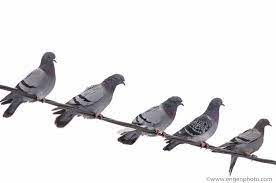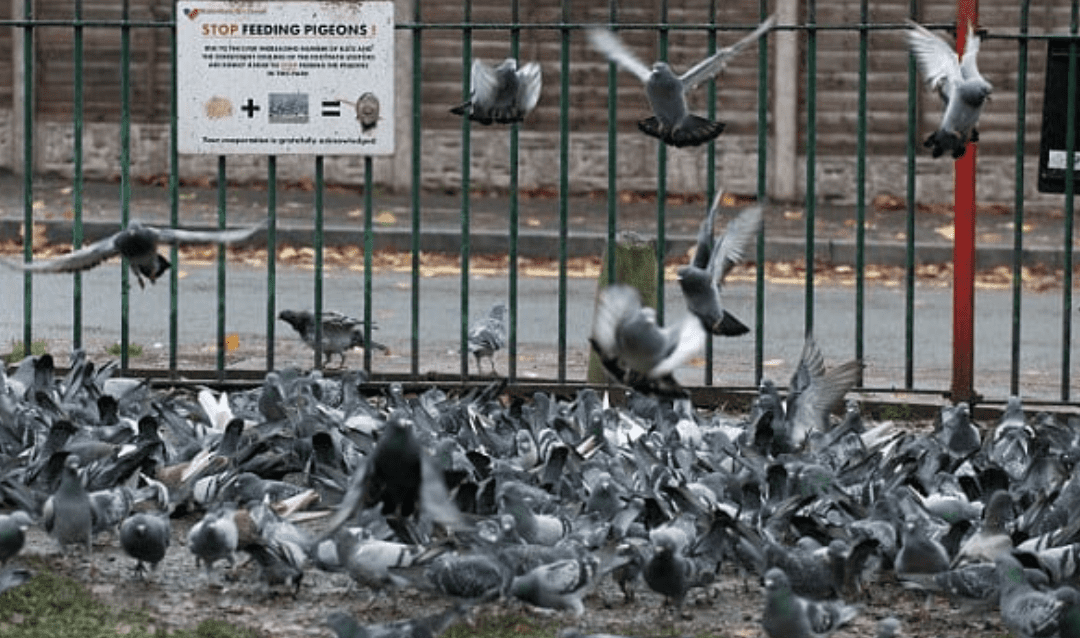
by Pigeon Patrol | Mar 7, 2022 | MBCA, pet bird, Pigeon Control, Pigeon Droppings, Pigeon Patrol's Services, Pigeon Predators
This morning as I was getting some worked finished, I noticed two crows on the roof across our ally. They had a large object which I first thought was something from the dumpster and then noticed what looked like it had chicken feet. I opened the window to get photos. Because it was cold out, the heat from my window made for some fierce shimmer and the photos are blurry…but you get the idea of what they are eating. Again, if you don’t like gross stuff, or don’t like the whole predator prey relationship thing, stop reading now.
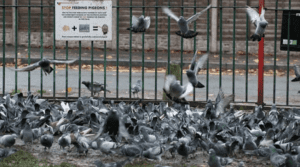
 When I first saw the feet, I was reminded of the quail that we get to feed the birds at The Raptor Center, but there are no quail around here. Then I realized that the bird the crows were eating had only pin feathers–it was a young bird from a nest. By the size, I realized that they were eating a pigeon nesting.
When I first saw the feet, I was reminded of the quail that we get to feed the birds at The Raptor Center, but there are no quail around here. Then I realized that the bird the crows were eating had only pin feathers–it was a young bird from a nest. By the size, I realized that they were eating a pigeon nesting.
 The two crows made short order of the chick. By the size and development, I would guess that the pigeon was about ten days old–which is interesting in and of itself. If the pigeon chick was about ten days old, the egg would have been laid 18 days before that, so the pigeon parents were busy in early March–at least two snow storms ago.
The two crows made short order of the chick. By the size and development, I would guess that the pigeon was about ten days old–which is interesting in and of itself. If the pigeon chick was about ten days old, the egg would have been laid 18 days before that, so the pigeon parents were busy in early March–at least two snow storms ago.
The pigeon nest was tucked in a nook on the roof of an apartment building just to the right of where the crows were eating. I’ve seen pigeons in and out of there all winter and assumed roosting–I didn’t guess that they were on eggs last month.
 When the crows were finished, I went back to business in my apartment. About fifteen minutes later I found them working on another chick. That surprised me. It makes sense to clean out a whole robin nest–those are small chicks, but a pigeon chick is fairly large, I was surprised that they ate both nestlings right away, but when you find a huge protein source like that and you are in the process of laying eggs yourself, you’re not gonna be able to resist it.
When the crows were finished, I went back to business in my apartment. About fifteen minutes later I found them working on another chick. That surprised me. It makes sense to clean out a whole robin nest–those are small chicks, but a pigeon chick is fairly large, I was surprised that they ate both nestlings right away, but when you find a huge protein source like that and you are in the process of laying eggs yourself, you’re not gonna be able to resist it.
 And let’s keep in mind that this is gross and it may not be pretty to watch a crow clean out a nest–but they are not the only ones to do it. Blue jays do it, hawks do it, owls do it–even woodpeckers do it. Heck, even nut job humans in England do it. Crows are just more obvious about it.
And let’s keep in mind that this is gross and it may not be pretty to watch a crow clean out a nest–but they are not the only ones to do it. Blue jays do it, hawks do it, owls do it–even woodpeckers do it. Heck, even nut job humans in England do it. Crows are just more obvious about it.
Source
Pigeon Patrol Products & Services is the leading manufacturer and distributor of bird deterrent (control) products in Canada. Pigeon Patrol products have solved pest bird problems in industrial, commercial, and residential settings since 2000, by using safe and humane bird deterrents with only bird and animal friendly solutions. At Pigeon Patrol, we manufacture and offer a variety of bird deterrents, ranging from Ultra-flex Bird Spikes with UV protection, Bird Netting, 4-S Bird Gel and the best Ultrasonic and audible sound devices on the market today.
Voted Best Canadian wholesaler for Bird Deterrent products ten years in a row.
Contact us at 1- 877– 4– NO-BIRD, (604) 585-9279 or visit our website at www.pigeonpatrol.ca
Pigeon/Pigeon Patrol / Pigeons Roosting / Vancouver Pigeon Control /Bird Spikes / Bird Control / Bird Deterrent / Pigeon Deterrent? Surrey Pigeon Control / Pest /Seagull deterrent / Vancouver Pigeon Blog / Birds Inside Home / Pigeons in the cities / Ice Pigeons/ What to do about pigeons/ sparrows , Damage by Sparrows, How To Keep Raccoons Away, Why Are Raccoons Considered Pests/ De-fence / Pigeon Nesting/ Bird Droppings / Pigeon Dropping/ woodpecker control/ Professional Bird Control Company/ Keep The Birds Away/ Birds/rats/ seagull/pigeon/woodpecker/ dove/sparrow/pidgeon control/pidgeon problem/ pidgeon control/flying rats/ pigeon Problems/ bird netting/bird gel/bird spray/bird nails/ bird guard

by Pigeon Patrol | Feb 22, 2022 | Bird Spike, Pigeon Predators, Pigeon Spikes, Pigeons, Pigeons in the News, Raccoons, Sparrows, UltraSonic Bird Control
Though they’re often described as “rats with wings” (a phrase popularized by the movie Stardust Memories), pigeons are actually pretty cool. From homing instincts to misleading rump feathers, here are 15 things you might not know about these avian adventurers.

1. THEY MIGHT BE THE FIRST DOMESTICATED BIRD.
The common city pigeon (Columba livia), also known as the rock pigeon, might be the first bird humankind ever domesticated. You can see them in art dating back as far as 4500 BCE in modern Iraq, and they’ve been a valuable source of food for thousands of years.
2. THEY WON OVER CHARLES DARWIN—AND NIKOLA TESLA.
Pigeon-breeding was a common hobby in Victorian England for everyone from well-off businessmen to average Joes, leading to some fantastically weird birds. Few hobbyists had more enthusiasm for the breeding process than Charles Darwin, who owned a diverse flock, joined London pigeon clubs, and hobnobbed with famous breeders. Darwin’s passion for the birds influenced his 1868 book The Variation of Animals and Plants Under Domestication, which has not one but two chapters about pigeons (dogs and cats share a single chapter).
Nikola Tesla was another great mind who enjoyed pigeons. He used to care for injured wild pigeons in his New York City hotel room. Hands down, Tesla’s favorite was a white female—about whom he once said, “I loved that pigeon, I loved her as a man loves a woman and she loved me. When she was ill, I knew and understood; she came to my room and I stayed beside her for days. I nursed her back to health. That pigeon was the joy of my life. If she needed me, nothing else mattered. As long as I had her, there was a purpose in my life.” Reportedly, he was inconsolable after she died.
3. THEY UNDERSTAND SPACE AND TIME.
In a 2017 Current Biology study, researchers showed captive pigeons a series of digital lines on a computer screen for either two or eight seconds. Some lines were short, measuring about 2.3 inches across; others were four times longer. The pigeons were trained to evaluate either the length of the line or how long it was displayed. They found that the more time a line was displayed, the longer in length the pigeon judged it to be. The reverse was true too: If the pigeons encountered a longer line, they thought it existed in time for a greater duration. Pigeons, the scientists concluded, understand the concepts of both time and space; the researchers noted “similar results have been found with humans and other primates.”
It’s thought that humans process those concepts with a brain region called the parietal cortex; pigeon brains lack that cortex, so they must have a different way of judging space and time.
4. THEY CAN FIND THEIR WAY BACK TO THE NEST FROM 1300 MILES AWAY.
The birds can do this even if they’ve been transported in isolation—with no visual, olfactory, or magnetic clues—while scientists rotate their cages so they don’t know what direction they’re traveling in. How they do this is a mystery, but people have been exploiting the pigeon’s navigational skills since at least 3000 BCE, when ancient peoples would set caged pigeons free and follow them to nearby land.
Their navigational skills also make pigeons great long-distance messengers. Sports fans in ancient Greece are said to have used trained pigeons to carry the results of the Ancient Olympics. Further east, Genghis Khan stayed in touch with his allies and enemies alike through a pigeon-based postal network.
5. THEY SAVED THOUSANDS OF HUMAN LIVES DURING WORLD WARS I AND II.
Pigeons’ homing talents continued to shape history during the 20th century. In both World Wars, rival nations had huge flocks of pigeon messengers. (America alone had 200,000 at its disposal in WWII.) By delivering critical updates, the avians saved thousands of human lives. One racing bird named Cher Ami completed a mission that led to the rescue of 194 stranded U.S. soldiers on October 4, 1918.
6. TWO PIGEONS ALMOST DISTRACTED FROM THE DISCOVERY OF EVIDENCE OF THE BIG BANG.
In 1964, scientists in Holmdel, New Jersey, heard hissing noises from their antenna that would later prove to be signals from the Big Bang. But when they first heard the sound, they thought it might be, among other things, the poop of two pigeons that were living in the antenna. “We took the pigeons, put them in a box, and mailed them as far away as we could in the company mail to a guy who fancied pigeons,” one of the scientists later recalled. “He looked at them and said these are junk pigeons and let them go and before long they were right back.” But the scientists were able to clean out the antenna and determine that they had not been the cause of the noise. The trap used to catch the birds (before they had to later be, uh, permanently removed) is on view at the Smithsonian Air & Space Museum.
7. YOU CAN TRAIN THEM TO BE ART SNOBS …
Japanese psychologist Shigeru Watanabe and two colleagues earned an Ig Nobel Prize in 1995 for training pigeons, in a lab setting, to recognize the paintings of Claude Monet and Pablo Picasso and to distinguish between the painters. The pigeons were even able to use their knowledge of impressionism and cubism to identify paintings of other artists in those movements. Later, Watanabe taught other pigeons to distinguish watercolor images from pastels. And in a 2009 experiment, captive pigeons he’d borrowed were shown almost two dozen paintings made by students at a Tokyo elementary school, and were taught which ones were considered “good” and which ones were considered “bad.” He then presented them with 10 new paintings and the avian critics managed to correctly guess which ones had earned bad grades from the school’s teacher and a panel of adults. Watanabe’s findings indicate that wild pigeons naturally categorize things on the basis of color, texture, and general appearance.
8. … AND TO DISTINGUISH WRITTEN WORDS.
In a 2016 study, scientists showed that pigeons can differentiate between strings of letters and actual words. Four of the birds built up a vocabulary of between 26 and 58 written English words, and though the birds couldn’t actually read them, they could identify visual patterns and therefore tell them apart. The birds could even identify words they hadn’t seen before.
9. FLUFFY PIGEON FEET MIGHT ACTUALLY BE PARTIAL WINGS.
A few pigeon breeds have fuzzy legs—which hobbyists call “muffs”—rather than scaly ones. According to a 2016 study, the DNA of these fluffy-footed pigeons leads their hind legs to take on some forelimb characteristics, making muffed pigeon legs look distinctly wing-like; they’re also big-boned. Not only do they have feathers, but the hindlimbs are somewhat big-boned, too. According to biologist Mike Shapiro, who led the study, “pigeons’ fancy feathered feet are partially wings.”
10. SOME PIGEONS DISTRACT FALCONS WITH WHITE RUMP FEATHERS.
In a life-or-death situation, a pigeon’s survival could depend upon its color pattern: Research has shown that wild falcons rarely go after pigeons that have a white patch of feathers just above the tail, and when the predators do target these birds, the attacks are rarely successful.
To figure out why this is, Ph.D. student Alberto Palleroni and a team tagged 5235 pigeons in the vicinity of Davis, California. Then, they monitored 1485 falcon-on-pigeon attacks over a seven-year span. The researchers found that although white-rumped pigeons comprised 20 to 25 percent of the area’s pigeon population, they represented less than 2 percent of all the observed pigeons that were killed by falcons; the vast majority of the victims had blue rumps. Palleroni and his team rounded up 756 white- and blue-rumped pigeons and swapped their rump feathers by clipping and pasting white feathers on blue rumps, and vice versa. The falcons had a much easier time spotting and catching the newly blue-rumped pigeons, while the pigeons that received the white feathers saw predation rates plummet.
Close observation revealed that the white patches distract birds of prey. In the wild, falcons dive-bomb other winged animals from above at high speeds. Some pigeons respond by rolling away in midair, and on a spiraling bird, white rump feathers can be eye-catching, which means that a patch of them may divert a hungry raptor’s focus long enough to make the carnivore miscalculate and zip right past its intended victim.
11. DODOS WERE RELATED TO TODAY’S PIGEONS.
Though most of this list focuses on the rock pigeon, there are 308 living species of pigeons and doves. Together, they make up an order of birds known as the columbiformes. The extinct dodo belonged to this group as well.
Flightless and (somewhat) docile, dodos once inhabited Mauritius, an island near Madagascar. The species had no natural predators, but when human sailors arrived with rats, dogs, cats, and pigs, it began to die out, and before the 17th century came to a close, the dodo had vanished altogether. DNA testing has confirmed that pigeons are closely related to the dodo, and the vibrant Nicobar pigeon (above) is its nearest genetic relative. A multi-colored bird with iridescent feathers, this near-threatened creature is found on small islands in the South Pacific and off Asia. Unlike the dodo, it can fly.
12. AT ONE POINT, MORE THAN ONE-QUARTER OF ALL THE BIRDS LIVING IN THE U.S. MAY HAVE BEEN PASSENGER PIGEONS.
Wild/feral rock pigeons reside in all 50 states, which makes it easy to forget that they’re invasive birds. Originally native to Eurasia and northern Africa, the species was (most likely) introduced to North America by French settlers in 1606. At the time, a different kind of columbiform—this one indigenous—was already thriving there: the passenger pigeon (Ectopistes migratorius). As many as 5 billion of them were living in America when England, Spain, and France first started colonizing, and they may have once represented anywhere from 25 to 40 percent of the total U.S. bird population. But by the early 20th century, they had become a rare sight, thanks to overhunting, habitat loss, and a possible genetic diversity issue. The last known passenger pigeon—a captive female named Martha—died on September 1, 1914.
13. THEY’RE REALLY GOOD AT MULTITASKING.
According to one study, they’re more efficient multitaskers than people are. Scientists at Ruhr-Universitat Bochum put together a test group of 15 humans and 12 pigeons and trained all of them to complete two simple jobs (like pressing a keyboard once a light bulb came on). They were also put in situations wherein they’d need to stop working on one job and switch over to another. In some trials, the participants had to make the change immediately. During these test runs, humans and pigeons switched between jobs at the same speed.
But in other trials, the test subjects were allowed to complete one assignment and then had to wait 300 milliseconds before moving on to the next job. Interestingly, in these runs, the pigeons were quicker to get started on that second task after the period ended. In the avian brain, nerve cells are more densely packed, which might enable our feathered friends to process information faster than we can under the right circumstances.
14. PIGEONS PRODUCE FAKE “MILK.”
Only mammals produce genuine milk, but pigeons and doves (along with some other species of birds) feed their young with something similar—a whitish liquid filled with nutrients, fats, antioxidants, and healthy proteins called “crop milk.” Both male and female pigeons create the milk in the crop, a section of the esophagus designed to store food temporarily. As is the case with mammal milk, the creation of crop milk is regulated by the hormone prolactin. Newly-hatched pigeons drink crop milk until they’re weaned off it after four weeks or so. (And if you’ve ever asked yourself, “Where are all the baby pigeons?” we have the answer for you right here.)
15. ONE STUDY SUGGESTS THAT, GIVEN THE RIGHT CONDITIONS, THEY’RE AS GOOD AT IDENTIFYING CANCER AS DOCTORS.
We’ve already established that pigeons are excellent at differentiating between artists and words, but a 2015 study revealed they can also distinguish between malignant and benign growths in the right conditions. Researchers at University of California Davis Medical Center put 16 pigeons in a room with magnified biopsies of potential breast cancers. If the pigeons correctly identified them as either benign or malignant, they got a treat, According to Scientific American.
“Once trained, the pigeons’ average diagnostic accuracy reached an impressive 85 percent. But when a “flock sourcing” approach was taken, in which the most common answer among all subjects was used, group accuracy climbed to a staggering 99 percent, or what would be expected from a pathologist. The pigeons were also able to apply their knowledge to novel images, showing the findings weren’t simply a result of rote memorization.”
Mammograms proved to be more of a challenge, however; the birds could memorize signs of cancer in the images they were trained on but could not identify the signs in new images.
No matter how impressive their results, “I don’t anticipate that pigeons, no matter how good they become at pathology or radiology, will be playing a role in actual patient care—certainly for the foreseeable future,” study co-author Richard M. Levenson told Scientific American. “There are just too many regulatory barriers—at least in the West.”
Source
Pigeon Patrol Products & Services is the leading manufacturer and distributor of bird deterrent (control) products in Canada. Pigeon Patrol products have solved pest bird problems in industrial, commercial, and residential settings since 2000, by using safe and humane bird deterrents with only bird and animal friendly solutions. At Pigeon Patrol, we manufacture and offer a variety of bird deterrents, ranging from Ultra-flex Bird Spikes with UV protection, Bird Netting, 4-S Bird Gel and the best Ultrasonic and audible sound devices on the market today.
Voted Best Canadian wholesaler for Bird Deterrent products ten years in a row.
Contact us at 1- 877– 4– NO-BIRD, (604) 585-9279 or visit our website at www.pigeonpatrol.ca
Pigeon/Pigeon Patrol / Pigeons Roosting / Vancouver Pigeon Control /Bird Spikes / Bird Control / Bird Deterrent / Pigeon Deterrent? Surrey Pigeon Control / Pest /Seagull deterrent / Vancouver Pigeon Blog / Birds Inside Home / Pigeons in the cities / Ice Pigeons/ What to do about pigeons/ sparrows , Damage by Sparrows, How To Keep Raccoons Away, Why Are Raccoons Considered Pests/ De-fence / Pigeon Nesting/ Bird Droppings / Pigeon Dropping/ woodpecker control/ Professional Bird Control Company/ Keep The Birds Away/ Birds/rats/ seagull/pigeon/woodpecker/ dove/sparrow/pidgeon control/pidgeon problem/ pidgeon control/flying rats/ pigeon Problems/ bird netting/bird gel/bird spray/bird nails/ bird guard
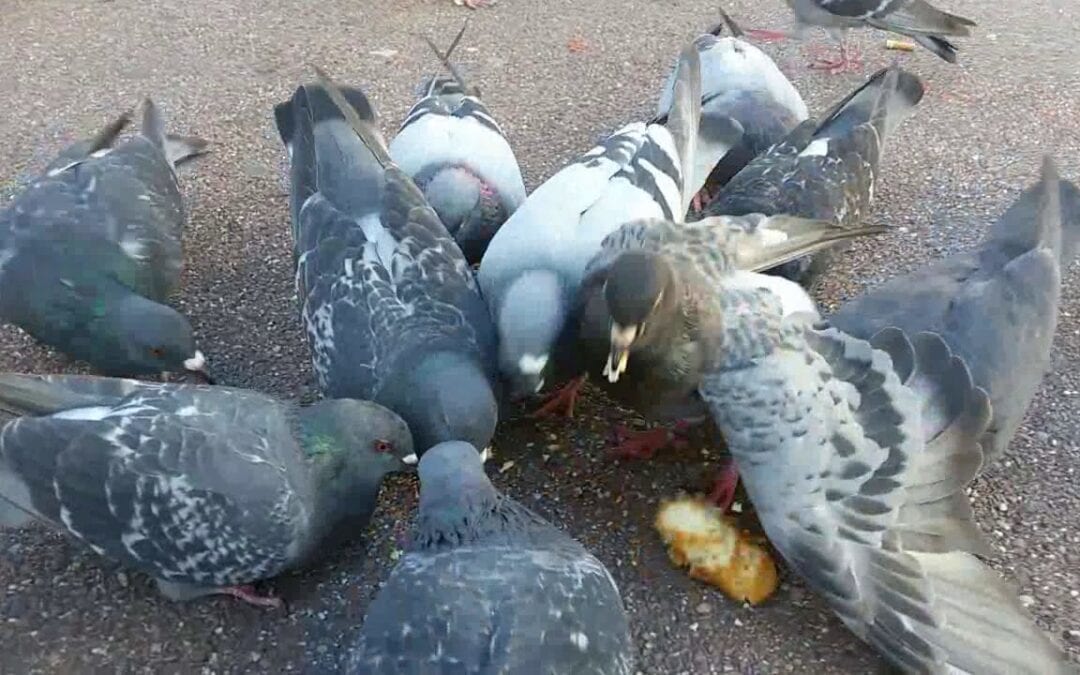
by Pigeon Patrol | Feb 22, 2022 | Bird Spike, Pigeon Patrol's Services, Pigeon Predators, Pigeon Spikes, Pigeons, Pigeons in the News
In his native Iran, Edwin Alexanderian said, pigeons are considered pets.
So about seven years ago, after seeing poisoned pigeons around his home in Brookline and along the street, Alexanderian decided to catch some of the birds and try to nurse them back to health.
When he’s successful, Alexanderian said, he releases the birds where he found them. If a pigeon does not recover completely, Alexanderian keeps it in a coop in his backyard. He now has about 80 pigeons.
“I decided to keep them because I don’t want to put them down,’’ he said.
But Alexanderian’s efforts to help the birds – which typically are poisoned in an effort to control the local population – are getting him in trouble with town officials. He was cited by the town because he never obtained a special permit for the shed-sized coop in his backyard. He’s also been warned by Brookline health officials that he doesn’t have the proper permit to keep the birds.
Health officials say neighbors have complained about a flock of pigeons hanging around Alexanderian’s Hammond Street home and defecating on neighboring rooftops.
“There is no other neighborhood that we have this going on,’’ said Pat Maloney, Brookline’s chief environmental health inspector.
Thomas French, assistant director of the state Division of Fisheries and Wildlife, said there is a chance that the pigeons being kept in a coop could attract other birds.
“They could be coming to visit,’’ French said. “That is a possibility.’’
But if a flock of pigeons are visiting Alexanderian’s coop, he said, they were probably already in the neighborhood and had not traveled a great distance.
Alexanderian, who is president of the Town Meeting Member Association in Brookline, said the pigeons flying around his neighborhood are not his birds, and blames the flock’s size on rat poison that was set out in the area and that has led to the deaths of most of the local hawks. Without the hawks, Alexanderian said, the pigeons have no predators to keep their numbers down.
Alexanderian said his pigeons are in his coop, and the reason he keeps so many of the birds is because once they’ve been poisoned, many are unable to fly long distances.
“They don’t die right away, it affects their brains,’’ Alexanderian said.
French said some poisons used on pigeons have neurological effects that make the birds act strangely and scare off other pigeons. He said MassWildlife issues permits for poisons to be used in an effort to keep pigeon populations at acceptable levels.
“I’ve never heard of anyone trying to intervene and save these birds,’’ French said.
But unless he can obtain the proper permits from the town, Alexanderian may not be able to rescue poisoned birds much longer.
Brookline’s zoning bylaws require that his pigeon coop be kept at least 100 feet away from neighboring properties, said Polly Selkoe, the town’s assistant director of regulatory planning.
Selkoe said Alexanderian’s property “is not really big enough to meet that’’ requirement, and he will need a special permit. Alexanderian said the building commission has already cited him for the coop, and he’s trying to obtain the special permit from the Zoning Board of Appeals.
Selkoe said Alexanderian’s hearing is Dec. 17. If he does get a special permit, Alexanderian would still need a permit from the town’s Board of Health to keep pigeons on his property, Maloney said.
While no one else in Brookline has a permit to keep pigeons, Maloney said, there are a handful of permits that have been issued for other animals, such as chickens, ducks and potbellied pigs.
Alexanderian said that he will fight to keep the pigeons, but if the town tells him he can’t keep them any more, he will release them.
“You think they got a problem now,’’ he said. “Wait until I release my sick birds.’’
Source
Pigeon Patrol Products & Services is the leading manufacturer and distributor of bird deterrent (control) products in Canada. Pigeon Patrol products have solved pest bird problems in industrial, commercial, and residential settings since 2000, by using safe and humane bird deterrents with only bird and animal friendly solutions. At Pigeon Patrol, we manufacture and offer a variety of bird deterrents, ranging from Ultra-flex Bird Spikes with UV protection, Bird Netting, 4-S Bird Gel and the best Ultrasonic and audible sound devices on the market today.
Voted Best Canadian wholesaler for Bird Deterrent products ten years in a row.
Contact us at 1- 877– 4– NO-BIRD, (604) 585-9279 or visit our website at www.pigeonpatrol.ca
Pigeon/Pigeon Patrol / Pigeons Roosting / Vancouver Pigeon Control /Bird Spikes / Bird Control / Bird Deterrent / Pigeon Deterrent? Surrey Pigeon Control / Pest /Seagull deterrent / Vancouver Pigeon Blog / Birds Inside Home / Pigeons in the cities / Ice Pigeons/ What to do about pigeons/ sparrows , Damage by Sparrows, How To Keep Raccoons Away, Why Are Raccoons Considered Pests/ De-fence / Pigeon Nesting/ Bird Droppings / Pigeon Dropping/ woodpecker control/ Professional Bird Control Company/ Keep The Birds Away/ Birds/rats/ seagull/pigeon/woodpecker/ dove/sparrow/pidgeon control/pidgeon problem/ pidgeon control/flying rats/ pigeon Problems/ bird netting/bird gel/bird spray/bird nails/ bird guard
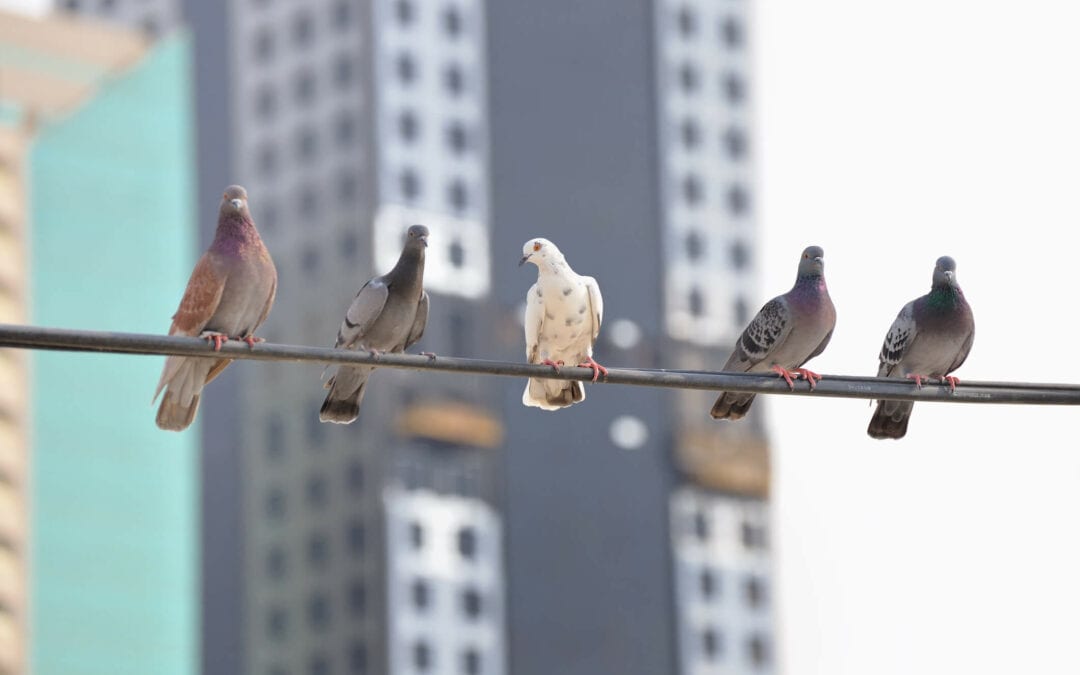
by Pigeon Patrol | Feb 16, 2022 | history of pigeons, MBCA, pet bird, Pigeon Control, Pigeon Droppings, Pigeon Patrol's Services, Pigeon Predators
Every spring, down-covered mallard ducklings follow their mother across a pond. Goslings graze along side their Canada Geese parents in waterfront parks. Baby chickens peck the ground soon after hatching. But why do we never see baby pigeons?
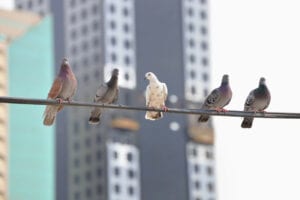
Some baby birds—like those down-covered ducks, geese, and chickens—leave their nest shortly after hatching and do a lot of growing up while following their parents around. Others, like pigeons, stay in the nest and depend on their parents to feed and protect them, well into their youth.
When young Rock Pigeons finally leave the nest, they are full sized with adult feathers, and they look like their parents. So unless you look carefully under a city bridge, you aren’t likely to ever see a baby pigeon.
It’s easy to imagine, when hearing soft cooing sounds like these, why baby pigeons would rather stay in the nest. But the reason is they wait to fledge until they are nearly independent and the task of getting on with life is a bit easier.
Source
Pigeon Patrol Products & Services is the leading manufacturer and distributor of bird deterrent (control) products in Canada. Pigeon Patrol products have solved pest bird problems in industrial, commercial, and residential settings since 2000, by using safe and humane bird deterrents with only bird and animal friendly solutions. At Pigeon Patrol, we manufacture and offer a variety of bird deterrents, ranging from Ultra-flex Bird Spikes with UV protection, Bird Netting, 4-S Bird Gel and the best Ultrasonic and audible sound devices on the market today.
Voted Best Canadian wholesaler for Bird Deterrent products ten years in a row.
Contact us at 1- 877– 4– NO-BIRD, (604) 585-9279 or visit our website at www.pigeonpatrol.ca
Pigeon/Pigeon Patrol / Pigeons Roosting / Vancouver Pigeon Control /Bird Spikes / Bird Control / Bird Deterrent / Pigeon Deterrent? Surrey Pigeon Control / Pest /Seagull deterrent / Vancouver Pigeon Blog / Birds Inside Home / Pigeons in the cities / Ice Pigeons/ What to do about pigeons/ sparrows , Damage by Sparrows, How To Keep Raccoons Away, Why Are Raccoons Considered Pests/ De-fence / Pigeon Nesting/ Bird Droppings / Pigeon Dropping/ woodpecker control/ Professional Bird Control Company/ Keep The Birds Away/ Birds/rats/ seagull/pigeon/woodpecker/ dove/sparrow/pidgeon control/pidgeon problem/ pidgeon control/flying rats/ pigeon Problems/ bird netting/bird gel/bird spray/bird nails/ bird guard

by Pigeon Patrol | Feb 16, 2022 | history of pigeons, MBCA, pet bird, Pigeon Control, Pigeon Droppings, Pigeon Patrol's Services, Pigeon Predators
Pigeons are beautiful to look at but they can also be a nuisance when they decide to invade your home. The cooing sounds can get loud and they’re known for messing up compounds with bird droppings and feathers. In addition to being annoying, pigeons also carry parasites and spread diseases. They roost in flocks and getting rid of them can be a challenge. Here are a few tips on how to get rid of pigeons without hurting them.
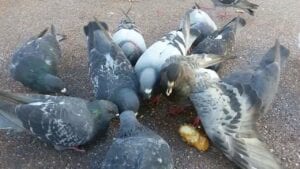
How to Get Rid of Pigeons Without Hurting Them
Pigeons can be a great nuisance, especially when they are in unwanted areas like a garden or under solar panels. Below is a list of a few ways to get rid of pigeons without hurting them.
Make Roosting Spaces Less Appealing
Make the spaces where pigeons land uncomfortably. You can achieve this by installing spike strips where the pigeons like to land. Make their nesting areas more difficult for them to survive by fastening the waterproof stings. This will make it harder for them to balance, forcing them to look for an alternative perching area.
Clean Upkeep
Keeping your surrounding clean is one of the best ways to keep pigeons away from your home. Keeping the grass trimmed low and having the trash picked up regularly will make your home less attractive to pigeons.
Avoid Feeding Them
Never feed pigeons or allow bird feeders to remain on your property. Feed pigeons and they’ll always return to places where they can find food.
Deter Pigeons from Your Roof
Block all exposed nooks and cover them with sturdy metal mesh. Inspect your entire house and seal off any potential entrances where pigeons can make their nests. Pigeons will commonly use chimneys, attics and window air conditioning units. To prevent them from making nests on or in these areas, seal off all entrances with a net.
Scare Off the Pigeons
Pigeons, like most birds, will scare easily. For instance, pressure washing pigeon holes with water will prevent the birds from returning. Alternatively, you can scare them off by placing a plastic owl in the yard, on a tree or close to the spot where they like to perch.
Hang wind chimes, a mirror or other reflecting surface in your garden. The reflection will irritate the pigeons and prevent them from coming back.
Get Rid of The Birdbath
Pigeons need water every day to survive. When there’s no water source, pigeons and insects won’t survive. Bird baths not only attract birds but also rodents and mosquitoes. If you can’t get rid of the birdbath, keep it clean and replace it with fresh water frequently.
Spray Honey Solution
This is one of the simplest yet most effective natural solutions to get rid of pigeons. Take a cup of water and mix it with a cup of honey. Pour the mixture into a spray bottle and spray the solution on areas frequented by the pigeons. Pigeons dislike sticky solutions and will naturally stop coming to your yard.
There are plenty of other tricks on how to get rid of pigeons without hurting them. Once they’re out of your yard, find ways to prevent them from coming back to your premises. The trick is to be consistent in your efforts. For more information, professionals from Pigeon Solutions can help you.
Source
Pigeon Patrol Products & Services is the leading manufacturer and distributor of bird deterrent (control) products in Canada. Pigeon Patrol products have solved pest bird problems in industrial, commercial, and residential settings since 2000, by using safe and humane bird deterrents with only bird and animal friendly solutions. At Pigeon Patrol, we manufacture and offer a variety of bird deterrents, ranging from Ultra-flex Bird Spikes with UV protection, Bird Netting, 4-S Bird Gel and the best Ultrasonic and audible sound devices on the market today.
Voted Best Canadian wholesaler for Bird Deterrent products ten years in a row.
Contact us at 1- 877– 4– NO-BIRD, (604) 585-9279 or visit our website at www.pigeonpatrol.ca
Pigeon/Pigeon Patrol / Pigeons Roosting / Vancouver Pigeon Control /Bird Spikes / Bird Control / Bird Deterrent / Pigeon Deterrent? Surrey Pigeon Control / Pest /Seagull deterrent / Vancouver Pigeon Blog / Birds Inside Home / Pigeons in the cities / Ice Pigeons/ What to do about pigeons/ sparrows , Damage by Sparrows, How To Keep Raccoons Away, Why Are Raccoons Considered Pests/ De-fence / Pigeon Nesting/ Bird Droppings / Pigeon Dropping/ woodpecker control/ Professional Bird Control Company/ Keep The Birds Away/ Birds/rats/ seagull/pigeon/woodpecker/ dove/sparrow/pidgeon control/pidgeon problem/ pidgeon control/flying rats/ pigeon Problems/ bird netting/bird gel/bird spray/bird nails/ bird guard


When I first saw the feet, I was reminded of the quail that we get to feed the birds at The Raptor Center, but there are no quail around here. Then I realized that the bird the crows were eating had only pin feathers–it was a young bird from a nest. By the size, I realized that they were eating a pigeon nesting.
The two crows made short order of the chick. By the size and development, I would guess that the pigeon was about ten days old–which is interesting in and of itself. If the pigeon chick was about ten days old, the egg would have been laid 18 days before that, so the pigeon parents were busy in early March–at least two snow storms ago.
When the crows were finished, I went back to business in my apartment. About fifteen minutes later I found them working on another chick. That surprised me. It makes sense to clean out a whole robin nest–those are small chicks, but a pigeon chick is fairly large, I was surprised that they ate both nestlings right away, but when you find a huge protein source like that and you are in the process of laying eggs yourself, you’re not gonna be able to resist it.
And let’s keep in mind that this is gross and it may not be pretty to watch a crow clean out a nest–but they are not the only ones to do it. Blue jays do it, hawks do it, owls do it–even woodpeckers do it. Heck, even nut job humans in England do it. Crows are just more obvious about it.







